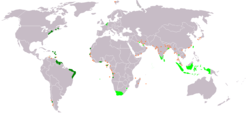Dutch colony
|
Dutch Empire
|
|
|---|---|

Flag
|
|

An anachronous map of the Dutch colonial Empire.
Light green: territories administered by or originating from territories administered by the Dutch East India Company |
|
| Membership |
28 countries |
Light green: territories administered by or originating from territories administered by the Dutch East India Company
28 countries
The Dutch Empire (Dutch: het Nederlandse koloniale rijk) comprised the overseas colonies, enclaves, and outposts controlled and administered by Dutch chartered companies and subsequently, the Dutch Republic and the modern Netherlands. It was initially a trade-based entity which derived most of its influence from merchant enterprise and Dutch control of international maritime shipping routes through strategically placed outposts, rather than expansive territorial ventures. With a few exceptions, the majority of the Dutch Empire's overseas holdings consisted of coastal forts, factories, and port settlements with varying degrees of incorporation of their hinterlands and surrounding regions. Dutch chartered companies often dictated that their possessions be kept as confined as possible to avoid unnecessary expense, and while some such as the Dutch Cape Colony and Dutch East Indies expanded anyway due to the pressure of independently minded Dutch colonists, others remained undeveloped, isolated trading centres dependent on an indigenous host nation. This was reflective of the fact that the primary network of the Dutch Empire was commercial exchange as opposed to sovereignty over a homogeneous landmass.
The imperial ambitions of the Dutch were bolstered by the strength of their existing shipping industry, as well as the key role they played in the expansion of maritime trade between Europe and the Orient. Because small European trading companies often lacked the capital or the manpower for large scale operations, the States General chartered the Dutch West India Company and the Dutch East India Company in the early 1600s. These were considered the largest and most extensive maritime trading companies at the time, and once held a virtual monopoly on strategic European shipping routes westward through the Strait of Magellan, and eastward around the Cape of Good Hope. The companies' brief domination of global commerce contributed greatly to a commercial revolution and a cultural flowering in the Netherlands known as the Dutch Golden Age. In their search for new trade passages between Asia and Europe Dutch navigators explored and charted vast regions such as New Zealand, Tasmania, and parts of the eastern coast of North America.
...
Wikipedia
